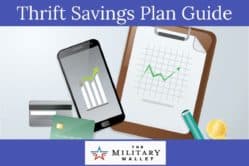The Thrift Savings Plan is similar to a 401k employer-sponsored retirement savings fund except it is used by the federal government. One of the benefits of employer-sponsored retirement plans is the ability to take advantage of tax benefits for retirement savings. The catch is once you make the contribution to the retirement account, you have to leave it there until retirement, unless you are willing to pay early withdrawal fees. However, there are some instances when you can gain access to your contributions before retirement age. Like a 401k, the Thrift Savings Plan allows participants to borrow against it under certain circumstances and conditions.
How to Take a Loan From Your Thrift Savings Plan
Here are the 6 things you need to know about borrowing from your Thrift Savings Plan account:
- You must have at least $1000 of your own contributions and earnings in the account to borrow money. You can not borrow from agency contributions or earnings. The maximum amount of money you can borrow is $50,000.
- You must be currently employed as a federal civilian employee or a member of the uniformed services to borrow money from you Thrift Savings Plan. Retired and separated individuals are not eligible for a loan.
- You must be in pay status. The loan repayments are deducted directly from your paycheck.
- You must not have repaid a previous loan of the same type in full within a 60 day period.
- You have not had a tax distribution on a loan within the past 12 months, unless it resulted from your separation with Federal service.
- You may still borrow from your Thrift Savings Plan account even if you have stopped making contributions with your own money.
Comparing Thrift Savings Plan Loans and Hardship Withdrawals: TSP loans require you repay the money you borrow; a TSP Hardship Withdrawal does not require you to repay the withdrawal. However, you will have to pay any associated taxes, penalties, and fees for early withdrawals.
Considerations Before Borrowing from Your TSP
There are two types of Thrift Savings Plan loans available from a TSP account. You can get a general purpose loan or you can use the loan to purchase a primary home. The money must be paid back, usually through direct deductions from payroll checks. There is no penalty for prepaying the loan and if a person is planning to retire or leave federal service, the loan must be repaid before then. Loans not repaid will result in the TSP declaring a taxable distribution for the balance of the due principle and interest.
Advantages and Disadvantages of Borrowing from Your TSP
When you borrow from your TSP, there are some advantages including paying yourself a decent amount of interest instead of giving the money to a third-party lender. Additionally, in the event of job loss or other problem resulting in the non-repayment of the loan, your credit will not be affected.
Disadvantages of the TSP loan include the fact you are paying taxes twice. You move tax-deferred assets into a state of taxation. After tax income is used to pay the loan. At the time of withdrawal during retirement, income tax must be paid again on the same funds.
When you take a loan against the TSP you also lose the growth ability of the account. Removing assets from your account will affect how much you will ultimately save. For those making repayments, they may not be able to contribute as much as they once hand.
Another disadvantage of the loan on a TSP is the potential tax penalty when you default on the loan repayment. You will end up paying federal and maybe state income taxes on the amount you did not pay. If you are not age 59 ½ at the time you default on the loan, you will pay early withdrawal penalties of 10% imposed by the IRS.
Conclusion: Thrift Savings Plan loans and 401k loans are available if you need access to your money, but there are risks involved. It is best to seek other alternatives before withdrawing funds from your retirement account.



Comments:
About the comments on this site:
These responses are not provided or commissioned by the bank advertiser. Responses have not been reviewed, approved or otherwise endorsed by the bank advertiser. It is not the bank advertiser’s responsibility to ensure all posts and/or questions are answered.
Claire says
I took a $20,000 loan out against my TSP. I have been making regular payments just fine. I plan to transfer Guard to Reserve. I learned (by calling a TSP agent) that they will get a code saying I am no longer in the military and it will be up to me to pay back the loan. If this is true, will they allow me to continue to make payments? I will not be able to make the payment in one lump sum.
Also…when I am officially in the Reserves (there will be no break in service but I am technically discharged then immediately back in), can I let TSP know and go back to the way it was before? Paying monthly?
Maybe there is no disruption at all and TSP will never know? The agent said that DFAS may not send that “code”. I can’t get ahold of DFAS so I was hoping that someone had the answer.
Ryan Guina says
Hello Claire, I don’t have an answer for you. I recommend contacting DFAS again during their customer service answers. You can also try getting something in writing from either DFAS or the TSP.
Those are the best organizations to answer this question.
I wish you the best, and thank you for your service!
Dawn says
I need advice. I have worked for the Gov for 10 years. I contributed the max for most of that time. My current situation includes 10000 worth up debt from credit cards, school loans, etc. I have been trying to pay them off for a while now. It is creating a hardship after a divorce and going to one income. If I took a withdrawal of 10000 from TSP to wipe my slate clean, would this be smart?? I don’t want debt. I’m also on the AF reserves. Any advice, please???
Micah says
To borrow money from my TSP account, I can only borrow what I have correct? I have only contributed 6K into my TSP at this point, so that is all I am able to borrow?
Ryan Guina says
Jennifer, I would try to avoid TSP loans because they can prove to be more expensive in the long run, especially if you leave government service before the loan is repaid, which could cause the loan to be due in full, or it would be counted as a distribution, leading to an immediate 10% early withdrawal penalty.
If it were me, I would look into getting a personal loan from a company such as Lending Club or Prosper. These companies facilitate Peer to Peer Loans, which lets regular people loan money to other people. You can often find better rates than you can through a bank.
That said, only you can make the final decision. I recommend checking out different options and weighing making the decision based on which is best for your specific situation.
Jennifer Lee says
So if you were trying to decide between a personal loan at 12% interest versus a TSP loan, what would be the smarter thing to do?
Ryan Guina says
Aron, I think you may be misunderstanding how TSP contributions work – the government isn’t giving anyone free money (with the exception of matching contributions, which are presently are not available to military members).
Contributions to the Thrift Savings Plan are tax deferred, meaning you don’t pay taxes on contributions when you make them. That gives you an immediate tax savings and you pay taxes on the money you make a qualified withdrawal in retirement age. So if you earn $10,000 and contribute $2,000, your paycheck is taxed as though you only earned $8,000. You would pay taxes on the $2,000 when you make a qualified withdrawal in retirement age. But there is no free money.
When you take out a TSP loan, you repay it with money that has already been taxed. Let’s look at your example of making $10,000 in contributions, then withdrawing that same amount as a loan.
The initial $10,000 was not taxed when it was contributed, and you will receive the full $10,000 as a loan. But when you repay your loan, you have to pay it back with money that has already been taxed. If you are in he 20% tax bracket, that means you will need to earn $12,500 to repay the $10,000 loan (assuming the 20% tax bracket you gave in your example; $10,000 is 80% of $12,500).
So you it will cost you $2,500 in taxes to be able to earn enough to repay your initial contribution. Then you get taxed on your withdrawals in retirement age, which can knock off another 20% or more in taxes. This is the double taxation I was referring to. There is a big disadvantage to being taxed twice.
Aron Rotklein says
I don’t understand the disadvantage of being taxed twice. Let’s pretend you put 10k into your TSP. If you are in the 20% bracket, you would have only received 8k of the 10k in your paycheck. Instead, the gov’t gave you a free 2k for the TSP account. Now you take out a 10k loan from your TSP. Of course you have to pay it back with after tax money. This does not negate the fact that the gov’t gave you a free 2k. When you take the money out at retirement, it is taxed just as if you never took a loan. The initial 2k tax advantage never disappeared.
reginald t barnes says
yes i would welcome all info from u ,and i do appreciate getting this information as often as u send them out